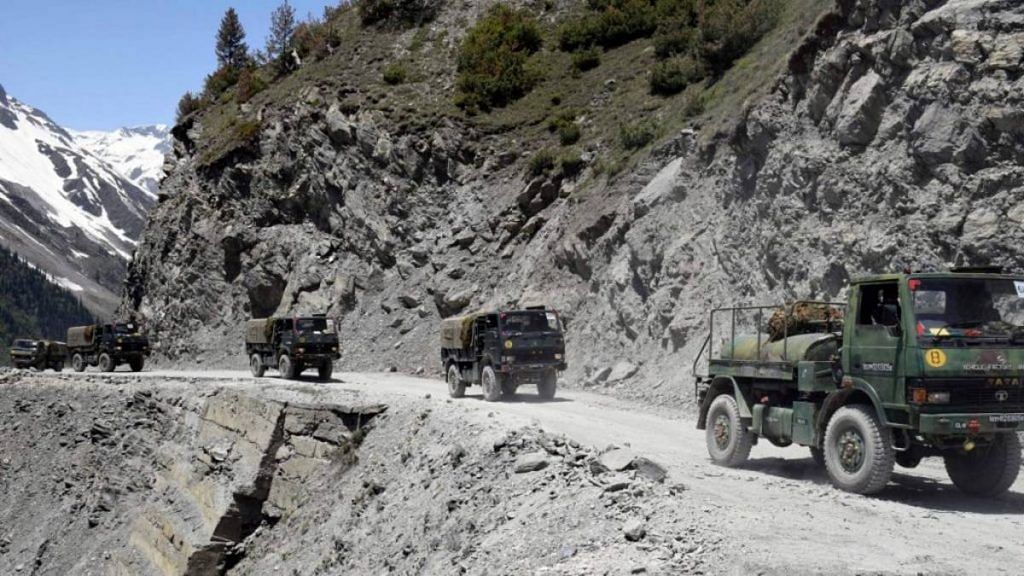New Delhi: With the last round of India-China corps commander-level talks doing little to ease tensions, sections of India’s strategic community are concerned that the confrontation could likely get worse at the Line of Actual Control (LAC) in eastern Ladakh, and that Beijing may not continue with the regular lines of communication.
While India didn’t expect movement on the disengagement plans, owing to China’s recent actions to deploy more troops at the LAC, the commentary from Beijing this time that India had made “unreasonable demands” has prompted strategic sources in New Delhi to believe that this could lead to a ‘Galwan-like’ flare-up, ThePrint has learnt.
According to sources, while the coming winter may be difficult for Indian troops, by March-April next year, there could even be a fresh bout of violence, including the possible use of firearms.
Sources also said that this time the Chinese had even hinted at “changing their approach” on lines of communication.
Ever since the LAC stand-off began in April-May 2020, both sides have mainly followed a three-tier approach — regular talks at the diplomatic and military levels, along with a dialogue track between External Affairs Minister S. Jaishankar and his Chinese counterpart Wang Yi.
To top all of this, talks were also held between National Security Advisor Ajit Doval and top Chinese diplomat Yang Jiechi. It was Doval and Yang who agreed to a disengagement plan in 2020.
Sources said that this time the talks failed as the Chinese have replaced Gen. Xu Qiling, who was promoted in July, with Gen. Wang Haijiang, and that as a result a “comfort level” had not been achieved.
Gen. Wang is the fourth commander to head the Western Theatre Command since the stand-off began. The decision to bring him in only in September was taken by the Central Military Commission (CMC), which heads the PLA.
Also read: China believes its time has come. But here’s what it hasn’t come to terms with yet
The sticky issues
While disengagement has taken place in the Pangong Tso area and at the Gogra Post, a stand-off continues over Patrolling Point 15 (PP15) in Hot Springs, the Depsang Plains and in the Demchok area.
India and China have six to seven hotlines but there has been little progress in the talks. A larger plan to resolve the issue with the establishment of a hotline at the DGMO level remains unfulfilled.
According to a source, both sides will be on edge this winter but India is well-prepared to face any kind of challenge.
“Hot Springs and Demchok continue to pose challenges. The Chinese have now made it a sovereignty issue, which is irksome. Earlier they were saying this is just a territorial issue. This should be noted,” said Lt Gen. Rakesh Sharma (retd), a Distinguished Fellow at the Centre for Land Warfare Studies (CLAWS).
“This kind of a situation has never happened in history. This is nothing like what had happened in other border incidents that we had with China,” Sharma added. “We just can’t equate it … India may have to come up with a new proposal to continue talking with the Chinese. And we need to stop talking about peace and tranquility all the time. Things are now beginning to look bad even in Tawang.”
India talks tough with China
The last round of military-level talks on 11 October, which was the 13th between forces of both countries, saw both sides exchange some strong words.
While India said it made some constructive suggestions for resolving the remaining areas, it found the Chinese side was “not agreeable and also could not provide any forward-looking proposals”.
The Chinese PLA, meanwhile, said that India “still persisted in its unreasonable and unrealistic demands, which added difficulties to the negotiations”.
“Over the past year-and-a-half, the India-China bilateral relationship has deteriorated like never before and it will continue to deteriorate further. So the country has to be prepared for the change that is coming,” said Gautam Bambawale, former Indian Ambassador to China.
“Unlike the last time, the Indian Army is now much well-prepared for the winter, there is better infrastructure and better provisioning.”
On Wednesday, India also slammed China for its comments on the visit of Vice-President Venkaiah Naidu to Arunachal Pradesh.
“Arunachal Pradesh is an integral and inalienable part of India. Indian leaders routinely travel to the state of Arunachal Pradesh as they do to any other state of India. Objecting to the visit of Indian leaders to a state of India does not stand to reason and understanding of Indian people,” Arindam Bagchi, Spokesperson, Ministry of External Affairs, said Wednesday.
“Further, as we have mentioned earlier, the current situation along the LAC in the western sector of the India-China border areas has been caused by unilateral attempts of the Chinese side to alter the status quo in violation of the bilateral agreements,” Bagchi added.
“Therefore, we expect the Chinese side to work towards early resolution of the remaining issues along the LAC in Eastern Ladakh while fully abiding by bilateral agreements and protocols rather than trying to link unrelated issues.”
He was reacting to Chinese Foreign Ministry spokesperson Zhao Lijian’s comments that the Chinese government has never recognised the “so-called Arunachal Pradesh established unilaterally and illegally by the Indian side and is firmly opposed to the Indian leader’s visit to the area concerned”.
(Edited by Arun Prashanth)
Also read: QUAD to AUKUS — How nations are challenging authoritarian Chinese culture
